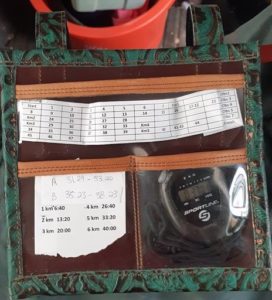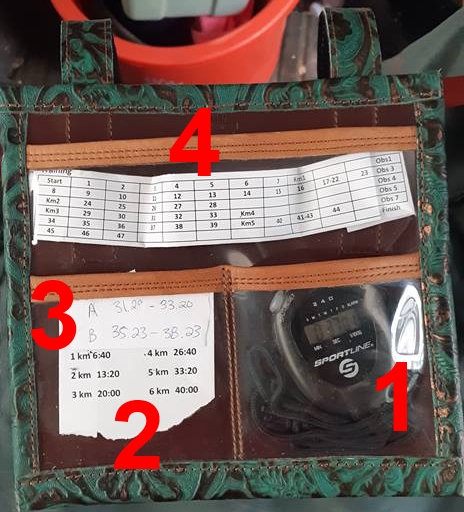When I posted a photo of Rocky’s path through the marathon last weekend at the Eagle Ridge CDE, it got a lot of attention and questions. I thought I’d make a post about how I manage the marathon, and keep track of my time, in case it would be helpful.
This is my holder I use for my paperwork. It’s beautiful, I got it from JSRI Show Equipment & Leatherworks when I was ordering new number holders. But until I had this, I just used a regular cart number holder, and attached it to the front of the cart, right where I can easily see it. Other people attach their papers to to their leg, or use other methods of holding them, but this has worked well for me. I also use this to hold my safety checklist before I had it in to the safety officer before the start of the marathon, and then my Green Card. You get a Green Card at the start, and your times are recorded all the way through at each phase, so you’ll need a spot to safely carry it along the way.
#1 – Most important tool you need is a stopwatch. I hate this one – I don’t communicate well with it and it beeps randomly and stresses me out. I used to have a good, straightforward one that I’d attached to a wristband which made it much easier to look at too – maybe I’ll find it again, but in the meantime I’ll be keeping an eye out for a new one that makes more sense to me! 😉 But regardless, you need a stopwatch or some way to track your time.
#2 – This is my cheatsheet of the “optimal time” for a training level VSE (9kph) to be at for each kilometer. That means that when I pass the 1 KM sign, I check and make sure that I am under six minutes and 40 seconds … but not too far under! If you get going too fast it is just as many penalties as too slow. Keeping track of your speed at each kilometer marker can help you make adjustments to stay within your time allowed window and avoid penalty points.
#3 – Posted at the event you’ll find the time allowed for each phase of the marathon. If you’re at a driving trial, vs a full combined driving event, you’ll likely only be doing Section B (that’s the part with the marathon obstacles), so you’ll only have one time allowed to worry about. Here I’ve included my window for both Section A and Section B. (There is also a time allowed for the walk section that falls in between the two, but no minimum – our time allowed was 17 minutes, and I didn’t write it down as I was pretty sure that wasn’t going to be an issue. I was right, he was closer to 10 minutes on the walk section.)
You’re allowed to come in 2 minutes less than the time allowed in Section A, and three minutes less in Section B, to be without penalties, so it is really important to know those numbers and have them with you. Section A is any pace, and in Section B you are allowed to walk the last 300m (or from the last hazard) so if you’re too fast you can use up some time that way, but only so much. It’s important to try to stay reasonably close to the time allowed all the way through, because there’s only so much you can fix at the end.
#4 – In the past when I’ve competed, I’ve had to make this list myself while on the course walk, but that this event they handed it out in our package! It’s been a while since I competed, hopefully that’s standard now, that’d be great! You also get a map of the course, but maps don’t make sense to me even when I have time to study them, let alone while driving a horse! This list is of the compulsory turning flags (a CTF is a numbered gate you have to go through, in order, to complete the course), plus the kilometer markers and the obstacles, in the order you’ll come to them. This is the way I find my way around the course – well, most of the time, I did go through a compulsory gate wrong in this event and get eliminated, but I didn’t get lost and knew immediately that I’d screwed up, thanks to this list. 😉
When you’re driving a single VSE, you usually don’t have a navigator to help you manage your time and figure out where you’re going, so it’s important to try and make all the information as accessible as possible. This is what I’ve found is effective for me, and while you might not want to use exactly the same method, hopefully it gives you some ideas! Driving a marathon is so fun, and the path is well marked, so don’t let the technical stuff scare you off. Read your rulebook, be prepared, and most importantly, have fun with your horse!


